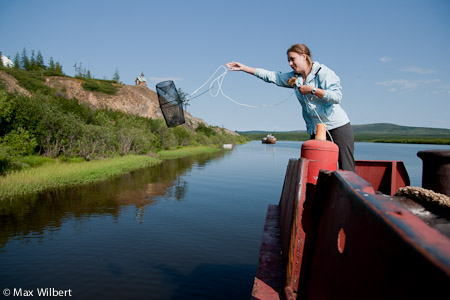As Max Holmes says, the atmosphere here at the station is a balance between student independence in projects and guidance by the PIs. He was telling me that as a group they want to give us as much guidance and advice as they can but at the same time it’s a necessary part of the process to get completely confused, distracted, and lost when it comes to our individual projects till inspiration hits and something beautiful happens.
That’s what my week has been like. This whole trip has been a fever pitch of new ideas then scratched ideas, only to be then resurrected and manipulated into something even more exciting. I came to the barge with an idea of studying upper trophic levels (fish in particular) and nutrient flow and food webs, only to have my interest peaked by Bill Sobsczak and the work he would be doing with bacterial respiration and biological oxygen demand of bacteria. Since that night I have proudly been a part of the BARGE (bacterial analysis research group extraordinaire) team.
My initial over arching question, what I had wanted the theme of my research here to revolve around, was ‘Why is the spring flush such a reactive period for bacteria when it’s so dang cold (1 – 4*C)?’ Normally bacteria, as most creatures, are restricted in metabolic rates by low temperatures. There could be a number of answers to that question however, and the work I wanted to do was mainly in answering which of those options was the most significant a factor.
Working around so many amazing people and interesting scientific projects has its downfalls though. I let myself be distracted by different ideas and possibilities and angles, as well as different (and rather intriguing) research projects altogether, that I lost sight of that original question. Today, that something beautiful happened. While on a walk with my project mentor (Bill) I was reminded to have confidence in my original project, and focus on my “shoebox” the one thing that was my work, that I could write about and present with confidence at the end of this trip, my contribution to Polaris 2010.
So far I have two experiments, done separately, seeking different angles of what might be effecting this high bioavailability (approximately 20% throughout the flush compared to an average of 5% through summer base flow months), including temperature and bacterial community differences. The something beautiful was the plan of a project bringing everything together. It goes back to my original question while still incorporating the work I’ve already done. This project will be a manipulation of filtered Kolyma water, looking at Spring bacteria vs. Summer bacteria vs. temperature vs. a new addition of manipulations; summer Kolyma water vs. Kolyma water with a detritus leachate added to replicate spring flush water. This project will bring everything together beautifully, coming full circle in my research and hopefully bringing enlightenment on what aspect is making the spring flush such an amazingly reactive period.





Comments(3)-
-
-
Marlene Robbins says
July 18, 2010 at 12:15 pmI’m glad you figured out a way to get the experiments to go full circle.
Marlene Robbins says
July 18, 2010 at 12:35 pmI’m glad you got the experiments to go full circle.
NOTmatthew says
July 22, 2010 at 9:59 pmYou sound so awesome, professional, and totally having the time of your life fighting off loads and tons of those lovely blood sucking vermin mosquitoes! Make sure you come back ready, prepped, and loaded to go with a full post-op debriefing.